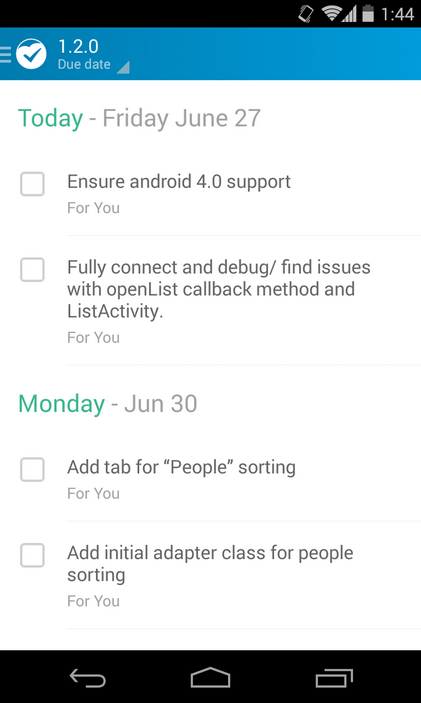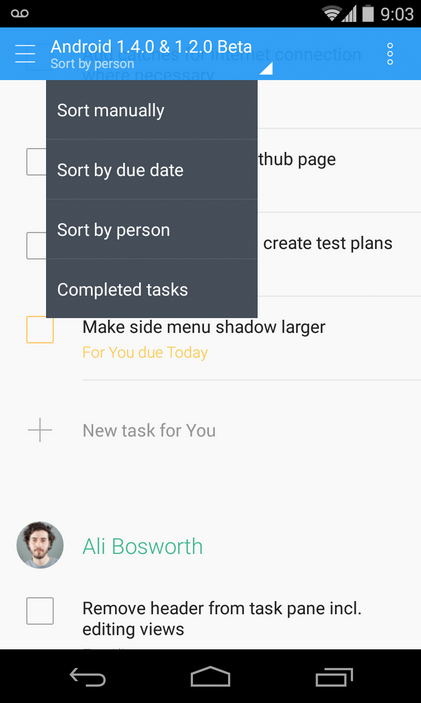We’re happy to announce that the Flow Android app has just been updated with major improvements. The bulk of the app is now native, making it faster and more reliable; we’ve thought carefully about bringing list and project creation to the platform; and we’ve added a bunch of polished interactions that make the app more pleasant to use. Download Flow for Android now and let us know what you think of the improvements by reviewing it on the Google Play Store.
Making it Native
From the start, our goal with the Android app has been to build the best experience for Flow on your phone. This update is a major step in that direction, in-fact it’s the largest update since launch. Looking at the project so far, we’ve been gradually turning it from a wrapped web-app (website) to a fully native experience that takes advantage of the platform’s strengths.
Here’s a brief overview of the app’s history:
- We started out simple, the first version of the app was just a natively wrapped website or web-app, with the ability to login and sign-up being native
- Then we built out native navigation - we started native development at the highest-level element of the app by building the sidebar menu. We started here because we knew we could branch off of the navigation to build out more native components and functionality
- Where we last left off was fixing major bugs before a hiatus while we worked on the bigger updates
Designing lists
We started this update initially just building lists, because they were the most complex views and thus the biggest design challenge. A nice intentional benefit from building lists first was that when it came time to build out the favorites views we could copy the design language and navigation over to them. This also created a more consistent experience. In short, we started with lists, established a general design, then worked backwards to build everything else.

Here’s the first design we built for lists. It follows the Android holo guidelines, but could be better in a lot of ways. The tabs take up too much space and are distracting; the gradient is lame; and there are lots of things that need to be stripped away and re-thought. Notably it doesn’t actually improve the experience much.

This iteration was getting closer. We got a lot right with the navigation. It’s cleaner, less distracting, and just as good at helping you navigate (we included “spinner” navigation, which is prevalent on Android.)

Almost there… this iteration added inline task creation. Note the “+” icon, which is actually a functional element that focuses the editText. It also has much better spacing between elements, and we moved more functionality into the overflow menu in the action bar.
The final design that we ended up going with can be seen in the video above.
Polished interactions
We don’t want to change Flow’s design unnecessarily as we build the app. However, we’re certainly enhancing interaction in ways only a native experience can. We’ve thought about how every swipe, menu, spinner, user flow, and bounce looks and feels. You’ll notice that the app isn’t just pretty looking, it wants to be poked and tapped and swiped, and the interface responds to that. All spring, list item, and button animations were pulled from Facebook Rebound’s open source project. Adding interactivity became a theme for this release; it has given the app a distinctive visual language and added personality to its productivity-focused interface.
Progress Update
In this release we:
- Built native functionality for list creation, viewing, and editing, Calendar, My Tasks, Inbox, Delegated, Subscribed, and Flagged
- Added the action bar everywhere. This adds navigation and functionality to the remaining views that are non-native (dashboard, search, and task pane)
- Completely re-designed every screen, animation, and interaction
- Improved performance
- Fixed lots of bugs
We’re now working on:
- Tasks - we’re going to spend time getting tasks right. We’d love to be able to attach photos, and create an experience with tasks that really fits and ties the app together
- Dashboard - this view deserves a lot of attention to detail. It’s complex, but shouldn’t be confusing, and should quickly give you the information you need
- Search - we’ve dramatically improved our search algorithm on the web, so we’ll be building native UI’s to really take advantage of that
- A widget - not for the sake of saying we have a widget, but because it’s genuinely helpful and complementary to the app. We’ll be working on ensuring its functionality and design fit the right context before we release anything
Open Source Projects
Facebook Rebound was mentioned above, but we also wanted to give a shoutout to all the open source projects we’ve used in the development of this latest release. They’ve made development quicker and better in a lot of ways. Big thank-yous go out to:
- Sliding Menu
- Action Bar Sherlock
- Enhanced List View
- View Pager Indicator
- Action Bar Pull To Refresh
- Smooth Progress Bar
- AnimatedExpandableListView
- AndroidViewAnimations
- ListViewAnimations
- Facebook Rebound Physics
- Fontify
- PixlUI
- AppMsg
Download Flow from the Google Play Store